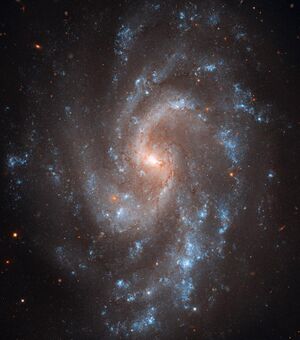Astronomy:NGC 5584
| NGC 5584 | |
|---|---|
 | |
| Observation data (J2000 epoch) | |
| Constellation | Virgo |
| Right ascension | 14h 22m 3.811s[2] |
| Declination | −00° 23′ 14.82″[2] |
| Redshift | 0.005525[3] |
| Helio radial velocity | 1,637 km/s[4] |
| Distance | 91.9 Mly (28.2 Mpc)[5] 75.0 Mly (23.01 Mpc)[6] 73.4 Mly (22.5 Mpc)[7] |
| Apparent magnitude (B) | 12.80 |
| Characteristics | |
| Type | SAB(rs)cd,[8] SA(s)cd[9] |
| Apparent size (V) | 1.320′ × 0.766′[2] |
| Other designations | |
| IRAS 14198-0009, NGC 5584, UGC 9201, MCG+00-37-001[3] | |
NGC 5584 is a barred spiral galaxy[8] in the constellation Virgo. It was discovered July 27, 1881 by American astronomer E. E. Barnard.[10] Distance determination using Cepheid variable measurements gives an estimate of 75 million light years,[6] whereas the tip of the red-giant branch approach yields a distance of 73.4 million light years.[7] It is receding with a heliocentric radial velocity of 1,637 km/s.[4] It is a member of the Virgo III Groups, a series of galaxies and galaxy clusters strung out to the east of the Virgo Supercluster of galaxies.[11]
The morphological class of NGC 5584 is SAB(rs)cd,[8] which indicates this spiral galaxy has an inner bar (SAB), an incomplete inner ring structure (rs), and loosely wound spiral arms (cd). It is flocculent in appearance with only a small nucleus. Star formation is occurring along the spiral arms.[8] The galactic plane is inclined at an angle of 42.4° to the line of sight from the Earth,[7] and it spans more than 50,000 light-years across.[12] 250 Cepheid variables have been observed in NGC 5584.[1]
Two supernova events have been observed in NGC 5584. SN 1996aq was a Type Ic supernova discovered August 17, 1996 by Masakatsu Aoki in Japan. It was offset by 15″ west and 8″ south of the galactic center. It reached magnitude 14.7 on August 18.[13] SN 2007af was spotted at magnitude 15.4 on February 24, 2007 by K. Itagaki, also of Japan. This was a Type Ia supernova at an offset 40″ west and 22″ of the galaxy center.[14] A light echo of this event was observed about 1,000 days after its discovery.[15]
References
- ↑ 1.0 1.1 "Hubble's View of NGC 5584". Hubble Heritage Project. https://hubblesite.org/contents/media/images/2011/08/2824-Image.html?news=true.
- ↑ 2.0 2.1 2.2 Skrutskie, Michael F. et al. (1 February 2006). "The Two Micron All Sky Survey (2MASS)". The Astronomical Journal 131 (2): 1163–1183. doi:10.1086/498708. ISSN 0004-6256. Bibcode: 2006AJ....131.1163S.
- ↑ 3.0 3.1 "NGC 5584". SIMBAD. Centre de données astronomiques de Strasbourg. http://simbad.u-strasbg.fr/simbad/sim-basic?Ident=NGC+5584.
- ↑ 4.0 4.1 van Driel, W. et al. (November 2016). "NIBLES: an H I census of stellar mass selected SDSS galaxies. I. The Nançay H I survey". Astronomy & Astrophysics 595: 43. doi:10.1051/0004-6361/201528048. A118. Bibcode: 2016A&A...595A.118V.
- ↑ Lianou, S. et al. (November 2019). "Dust properties and star formation of approximately a thousand local galaxies". Astronomy & Astrophysics 631: 19. doi:10.1051/0004-6361/201834553. A38. Bibcode: 2019A&A...631A..38L.
- ↑ 6.0 6.1 Javanmardi, Behnam et al. (April 2021). "Inspecting the Cepheid Distance Ladder: the Hubble Space Telescope Distance to the SN Ia Host Galaxy NGC 5584". The Astrophysical Journal 911 (1): 21. doi:10.3847/1538-4357/abe7e5. 12. Bibcode: 2021ApJ...911...12J.
- ↑ 7.0 7.1 7.2 Jang, In; Lee, Myung Gyoon (July 2015). "The Tip of the Red Giant Branch Distances to Type Ia Supernova Host Galaxies. III. NGC 4038/39 and NGC 5584". The Astrophysical Journal 807 (2): 12. doi:10.1088/0004-637X/807/2/133. 133. Bibcode: 2015ApJ...807..133J.
- ↑ 8.0 8.1 8.2 8.3 Das, M. et al. (July 2012). "Star formation in bulgeless late-type galaxies: clues to their evolution". Monthly Notices of the Royal Astronomical Society 423 (4): 3274–3284. doi:10.1111/j.1365-2966.2012.21120.x. Bibcode: 2012MNRAS.423.3274D.
- ↑ Buta, Ronald J. et al. (September 2019). "A comprehensive examination of the optical morphologies of 719 isolated galaxies in the AMIGA sample". Monthly Notices of the Royal Astronomical Society 488 (2): 2175–2189. doi:10.1093/mnras/stz1780. Bibcode: 2019MNRAS.488.2175B.
- ↑ Kronk, Gary W. (2017). Lewis Swift, Celebrated Comet Hunter and the People's Astronomer. Springer International Publishing. p. 107. ISBN 9783319637211. https://books.google.com/books?id=kas2DwAAQBAJ&pg=PA107.
- ↑ "The Virgo III Groups". Atlas of the Universe. http://www.atlasoftheuniverse.com/galgrps/viriii.html.
- ↑ Nemiroff, R.; Bonnell, J., eds (2011-03-30). "NGC 5584: Expanding the Universe". Astronomy Picture of the Day. NASA. https://apod.nasa.gov/apod/ap110330.html.
- ↑ Nakano, S. et al. (August 1996). Green, D. W. E.. ed. "Supernova 1996aq in NGC 5584". IAU Circular 6454 (1): 1. Bibcode: 1996IAUC.6454....1N.
- ↑ Hurst, G. M. (October 2007). "Supernova 2007af in NGC 5584". Journal of the British Astronomical Association 117 (5): 280–281. Bibcode: 2007JBAA..117..280H.
- ↑ Drozdov, Dina; Leising, M. D.; Milne, P.; Riess, A. G. (June 2013). "The Detection of a Light Echo from Type Ia SN 2007af in NGC 5584". American Astronomical Society, AAS Meeting #222 222. 118.04. Bibcode: 2013AAS...22211804D.
External links
- Spiral Key to Universe's Expansion: ESA/Hubble Picture of the week.
 |

